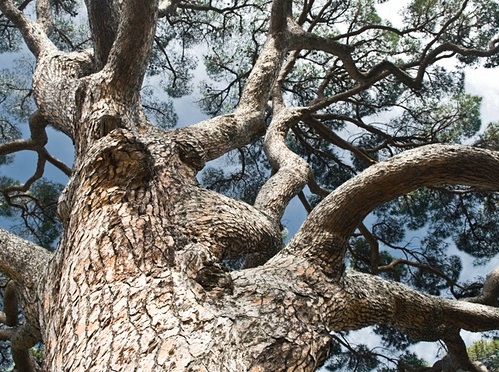
西南松柏面临气候挑战
Southwest's Conifers Face Trial by Climate Change
西南松柏面临气候挑战
Using climate models and tree physiological data, researchers forecast a near-complete annihilation of evergreens in the southwest by the year 2100. Christopher Intagliata reports
根据气候模型和树木生理学数据,研究人员预测,到2100年,西南部的常绿树木将近乎灭绝。
撰文/播音 克里斯托弗·因塔利亚塔(Christopher Intagliata)
翻译 Meatle
审校 邰伦玥
As you sit round the Christmas tree, consider the TLC you give O Tannenbaum: plenty of water and a relatively comfortable climate. Wouldn't want to dry out the tree, after all. Now consider that in the house we all live in—the planet—we’re hardly giving the same courtesy to your Christmas tree's wild cousins. (Who, I might add, are actually still alive.)
当你围坐在圣诞树旁时,想想你对这树的全面呵护:你为它提供充足的水分与相对舒适的环境,全为了不让它干枯。现在想想我们共同居住的地方——地球,我们几乎没有给予圣诞树的同胞们与圣诞树相同的恩宠。(当然,这些树仍然存活着。)
As the planet warms, droughts are getting even drier—and they're getting hotter too. In fact it's getting so bad that researchers are now forecasting that conifers in the arid southwestern United States could be completely wiped out by the end of the century. No more pinyon pines, ponderosas or junipers. No more forests.
伴随着全球变暖,干旱变得严重,同时也更为炎热。实际上,情况是如此不济:研究人员预测,在本世纪末,美国西南部荒漠地区的针叶树木将会灭绝。再不会有矮松、黄松和杜松,再不会有森林。
"It's definitely a distressing result for all of us. None of us want to see this happen. It's a bummer, honestly." Sara Rauscher, a climate scientist and geographer at the University of Delaware. She and her colleagues gathered data on how real-world evergreens in the southwest respond to drought and heat—they basically starve, unable to carry on photosynthesis or transport water.
“对我们来说这绝对是一个令人痛苦的结论。没有人想看到这种事发生。这真心是一个令人失望的状况。”特拉华州大学的气象科学家与地理学家,沙拉·劳舍尔说。她和她的同事收集了西南地区的自然状态中生活的常绿树木对干旱和酷热的反应数据。这些树木在上述恶劣环境中无法继续进行光合作用或摄取水分,它们只能挨饿。
The researchers then combined those physiological data with a half dozen projections of how climate change might proceed. "But no matter what model we used, we always saw tree death." Specifically, 72 percent of the trees dead by 2050, and a near-complete annihilation by the year 2100. The results are in the journal Nature Climate Change. [N. G. McDowell et al, Multi-scale predictions of massive conifer mortality due to chronic temperature rise]
然后,研究人员将那些树木生理学数组与六组气候变化预测数据组合起来,“无论使用什么模型,我们总是看到树木死亡的结论。”这个结论明确了72%的树木将于2050死亡,并在2100年近乎灭绝。这个结论发表在《自然气候变化》上。
But we'll always have Paris, right? "Even if we used a scenario similar to what the Paris accords have agreed upon—so limiting global warming to 2 degrees—we still saw widespread die-off. It happened later in the century, but it still happened." That said, the study does not account for trees' ability to adapt, or whether new populations could find friendlier climes. That is, whether conifers in the southwest can pull up roots fast enough to beat climate change.
但是我们还有巴黎会议呢,对吧?“即使我们限制气候升高的水平在2℃,也就是使用巴黎协议达成一致的情景进行分析,我们仍然无法避免这些树木的灭绝。在这种状况下,树木灭绝的时间有所延迟,但仍会在本世纪中发生。”尽管如此,这项研究没有考虑树木的适应能力,或是新的种群能否找到更适合生长的气候。也就是说,这些在西南部地区的松柏能否尽快转移以对抗气候变化。
未经书面许可任何人不得复制或镜像
京ICP备11000850号-1
 京公网安备11010502039775号
京公网安备11010502039775号 信息网络传播视听节目许可证0111611号
国家科技基础条件平台

















